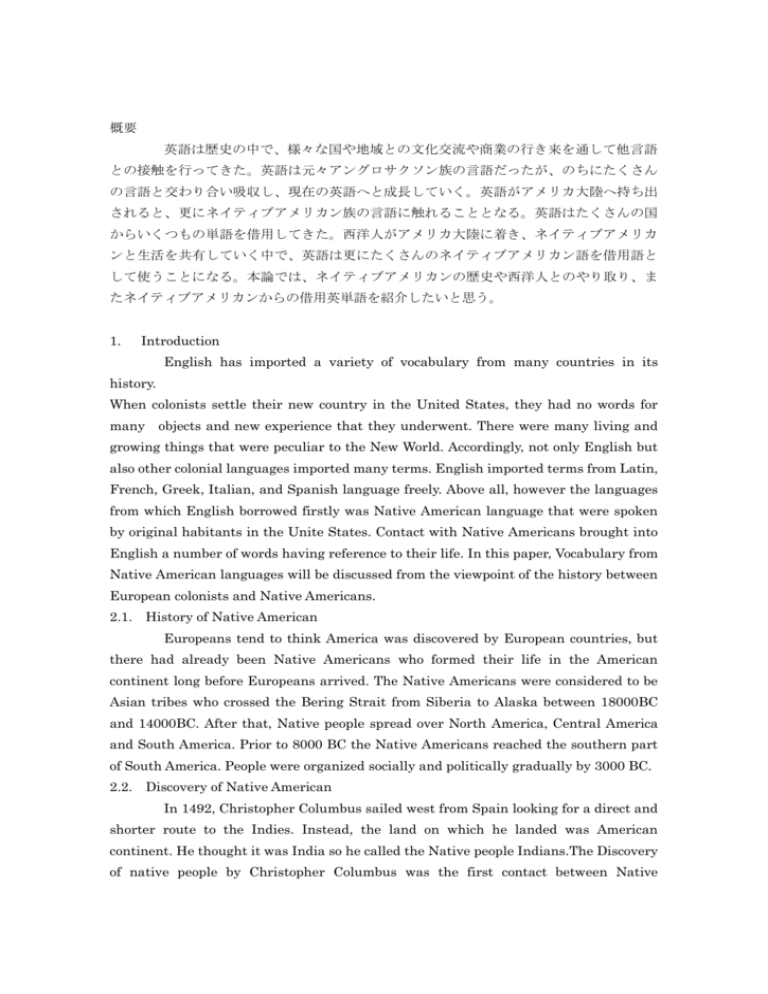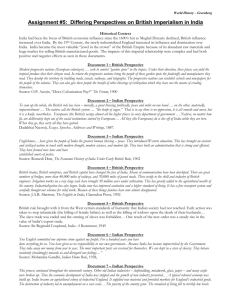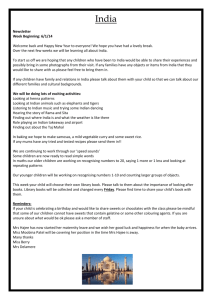southwest areas
advertisement

概要 英語は歴史の中で、様々な国や地域との文化交流や商業の行き来を通して他言語 との接触を行ってきた。英語は元々アングロサクソン族の言語だったが、のちにたくさん の言語と交わり合い吸収し、現在の英語へと成長していく。英語がアメリカ大陸へ持ち出 されると、更にネイティブアメリカン族の言語に触れることとなる。英語はたくさんの国 からいくつもの単語を借用してきた。西洋人がアメリカ大陸に着き、ネイティブアメリカ ンと生活を共有していく中で、英語は更にたくさんのネイティブアメリカン語を借用語と して使うことになる。本論では、ネイティブアメリカンの歴史や西洋人とのやり取り、ま たネイティブアメリカンからの借用英単語を紹介したいと思う。 1. Introduction English has imported a variety of vocabulary from many countries in its history. When colonists settle their new country in the United States, they had no words for many objects and new experience that they underwent. There were many living and growing things that were peculiar to the New World. Accordingly, not only English but also other colonial languages imported many terms. English imported terms from Latin, French, Greek, Italian, and Spanish language freely. Above all, however the languages from which English borrowed firstly was Native American language that were spoken by original habitants in the Unite States. Contact with Native Americans brought into English a number of words having reference to their life. In this paper, Vocabulary from Native American languages will be discussed from the viewpoint of the history between European colonists and Native Americans. 2.1. History of Native American Europeans tend to think America was discovered by European countries, but there had already been Native Americans who formed their life in the American continent long before Europeans arrived. The Native Americans were considered to be Asian tribes who crossed the Bering Strait from Siberia to Alaska between 18000BC and 14000BC. After that, Native people spread over North America, Central America and South America. Prior to 8000 BC the Native Americans reached the southern part of South America. People were organized socially and politically gradually by 3000 BC. 2.2. Discovery of Native American In 1492, Christopher Columbus sailed west from Spain looking for a direct and shorter route to the Indies. Instead, the land on which he landed was American continent. He thought it was India so he called the Native people Indians.The Discovery of native people by Christopher Columbus was the first contact between Native American and Europeans. By the time he came to the New World, the native population of North America was estimated at about 500,000 people and there were about 500 tribes. According to Welker (2002), “at the time of first European contact, probably close to 1,000 American Indian languages were spoken in North, Central, and South America. Although the number of languages in daily use has declined because of persecution and pressures on the Indians to adopt English, Spanish, and other original European languages. Perhaps 300 languages were spoken in Canada and the United States when the first Europeans arrived, and about 200 are still spoken by some 300,000 people.”1 2.3. Cultural and Colonial areas The areas which were occupied by Native Americans with similar cultures are divided into ten areas. They are the Northwest coast, California, Northeast, Southeast, Great Plains, Plateau, Great Basin, Southwest, Arctic and Subarctic areas. As the Europeans arrived, Russian explorers came to occupy most of the southern coast of what is now Alaska. French expansion started from Quebec in Canada and went over Mississippi River areas. English settlement founded on New England areas and some southeast areas. Dutch explored Hudson Bay areas of east coast. Spanish explorers had the greatest power of any European explorers and occupied Southwest areas which are now Mexico, California areas and Florida. 2.4. Cultural Exchange Contact between Europeans and Native peoples began in the early 1500s and continued for a century before European started to make settlements. This is the first opportunity for English to have direct contact with North American languages that is Native American languages. They contributed to a great expansion of knowledge, which was reflected in the linguistic borrowings. Through living with Native Americans, Columbus and other Europeans made discoveries of new plants, animals, customs, buildings and living sources that they had not known. 3.1. Native American Vocabulary Loans in English Vocabulary from Native American languages was mostly borrowed in the seventeenth and eighteenth centuries. After the nineteenth century, words were rarely loaned. Indian’s living styles are reflected in English vocabulary. Plants and animals words from Native Americans are often loaned to other languages as well. Indian 1 From http://www.indigenouspeople.net/americas/americas.htm languages are powerful language which reflected plants and animal names in American English. It is also significant that many place names in the United States are based on Native American vocabulary. Native American languages are often agglutinative languages like Japanese, Korean, and Altai language. Prefixes, infixes and suffixes are often used. They are not a single language but consist of many languages. During seventeenth and eighteenth centuries, a group of Algonquian languages was often the source of loan words. This is because Algonquians were distributed over the eastern area, which was being settled by Europeans. Other Indian terms were loaned after nineteenth century. As Europeans exploited the west, loan words of different languages were introduced. 3.2. Cultural loan words From their earliest contact with early traders and explorers, Native Americans taught them new words often to describe things and food. The following gives specific examples of vocabulary which was loaned by Native Americans. These examples are divided into six categories: animals, plants, buildings, tools, food and miscellaneous. 1.Animals: skunk, moose, raccoon, opossum, menhaden, terrapin, woodchuck, muskellunge, wapiti, chipmunk, cayuse 2.Plants: persimmon, chinquapin, hickory, squash, catalpa, tamarack, sequoia 3.Buildings: wigwam, tepee, hogan 4.Tools: moccasin, tomahawk, totem, parka, atlatl 5.Food: pone, hominy, hoochinoo, bean, peanut, tomato, papaya, pineapple, avocado, chile pepper, cocoa, maize 6.Other: sachem, powwow, papoose, squaw, mugwump, potlatch, chautauqua 3.3. Place Names In addition, many American places have been named after Indian words. Places including some states, rivers, lakes and cities in the United States are originally from Native American languages. Actually thousands of place names including Ottawa, Toronto, Saskatchewan and the names of more than half of the states of the US come from Native American languages. More than a thousand rivers also have names of Native American origin. Indian languages had a great influence on place names. The following state names, city names and river name and lake names are from Indian words. States Indiana → “land of Indians” Iowa → “this is the place”, “the beautiful land” Kansas → “people of the south wind” Kentucky → “land of tomorrow” Michigan → “great or large lake” Ohio → “great river” Texas → “friends” Utah → “people of the mountains” Cities Chicago → “garlic field” Manhattan → “isolated thing in water” Milwaukee → “a good spot or place” Pensacola (Florida) → “hair” “people” Saratoga (New York) → “springs from the hillside” Rivers and lakes Mississippi → “father of waters” Except Superior, all of the great lakes Lake Tahoe → “big water” of Michigan, Erie, Ontario and Huron have Native American names. The Adirondack Mountains, Appalachian Mountains, Chesapeake Bay, Penobscot Bay, Mohave Desert, Yosemite National Park and Niagara falls are also originally from Indian words.2 4. Conclusion Native American language have contributed to the vocabularies of English and many other Old World languages, especially words for animals, plants and culture traits unknown to Europeans before the discovery of the New World. Native American life styles are reflected in English Vocabulary. Among many Native American languages, most words are borrowed from Algonquian language. Today interest in Native American language is increasing. Indeed, some Native American languages are becoming culturally and politically important. Wherever you go in the US, you will see a lot of Native American words there, especially place names. 5. 2 Bibliography http://www.factmonster.com/spot/aihmnames1.html Nagai, Y (0000) Amerika no hougen.(American English Dialect , in Japanese).Tokyo: Nanundou. Takahasi, T (0000) Amerika Eigo (American English , in Japanese).Tokyo: Saimaru shuppansha. Takebayasi, J (0000) Amerika Eigo gaisetu (American English Introduction, in Japanese).Tokyo: Taishukan shoten. Trudgill Peter, Hannah Jean (1982) International English . New York: Edward Arnold. Varieties of English “American Indian English” Available at, http://www.ic.arizona.edu/~lsp/index.html (12/11/2003) Infoplease.com. All the knowledge you need “American Indian Loan Words” Available at, http://www.infoplease.com/spot/aihmwords1.html (12/11/2003) Words in English (2003) “Loanwords” Available at, http://www.ruf.rice.edu/~kemmer/Words/loanwords.html (12/11/2003) The Metaverse “Words in English from Amerindian Languages” Available at, http://www.zompist.com/indianwd.html (12/11/2003) Wikipedia.The free encyclopedia (2003) “English language” Available at, http://en.wikipedia.org/wiki/English_language (12/11/2003) Smithsonian Institution “Paleoamerican Origins” Available at, http://www.si.edu/history_and_culture/american_indian/(11/01/2003 Ampersand “Indian” Available at, http://www.ampersand.jp/indian.html(11/01/2003) Eastern Algonquian Language Revitalization: A Chronology of Change Available at, http://www.bluekungfu.com/archaeological/Native-American/Algonquin-Language-Reva tilization.html (11/01/2003) Fact Monster. Information Please “American Indian Place Names” Available at, http://www.factmonster.com/spot/aihmnames1.html (12/10/2003) Indigenous peoples literature “Native American Languages” Available at, http://www.indigenouspeople.net/americas/americas.htm (11/01/2003)







